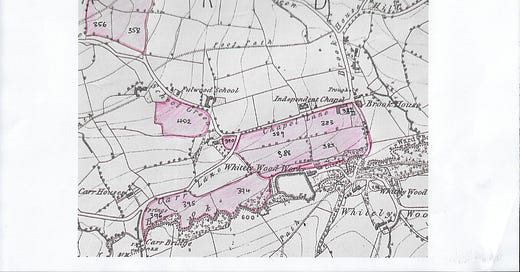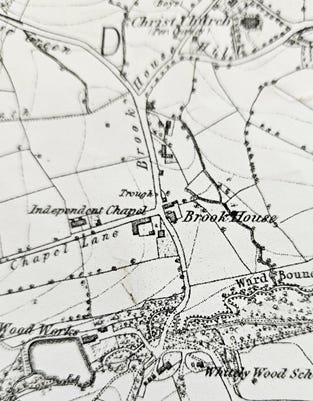As part of the old Fulwood A-Z project of old buildings in Fulwood that I am attempting to compile I have started researching Brook House. Sounds easy enough. parish registers, newspaper reports, various archives, Ancestry, rating and voting records usually give you a basis on which to begin. In this case what was good was the number of interesting people that the research threw up, Not so good was the sheer volume of people that seemed to be living there at the same time!
Eventually the penny dropped, Brook House in historic records is not the Brook House of today. In those records Brook House describes an area and not just the house that now bears the name.
It all goes back to Brookhouse Farm, the old barns of which are still visible on Whiteley Lane. These are clearly shown towards the top of this extract from the Fairbanks maps of the whole of Upper Hallam dated 1795, the originals of which are held in Sheffield archives.
The key to the plans show that the Duke of Norfolk was the owner of all the property shaded green. Brookhouse Farm was rented from him by Thomas Haywood. Thomas and his wife Hannah (the daughter and heir of Adam Hawksworth) were living at Brook House Farm in 1791, with their eldest son John Haywood as that is the address given for them in a conveyance of the family interest in Bennet Grange, where both Thomas and John are described as farmers of Brookhouse.
The farm was extensive. It extended all the way down to the River Porter. The farm buildings were described as 382 – The Homestead and the lane leading down to the Dams on the river (384) was part of the holding as were the parts marked 383, 385, 386, 387, 388, 389 and 390 on this plan. Other fields were rented from the Duke of Norfolk (355, 356 and 358 on plan 9) and some were rented from the Town Trustees (394, 395, 396 and 402).
I have consolidated all the above information and superimposed it onto the first Ordnance Survey map of the area, which is the first accurate map of the whole area, and which was surveyed in 1851/2. The only substantial changes between 1795, the date of the above map, and the early 1850’s in this part of Fulwood, are the fact that Christchurch has been built at the top of Brookhouse Hill, the area around the Dams has more trackways and the building now called Brook House has been built on part of the Brookhouse Farm land. The extent of Brookhouse Farm is shown coloured pink and edged red on the next plan. Some further fields were rented further up Crimicar Lane. Those may also have been farmed from Brookhouse Farm or may have been sublet, so I have not included them on the following plan.
In the series of 1795 maps, land on the other side of Brookhouse Hill is included on plan 16. Note the small building marked 789a. That building is described as a cart house and forge rented from the Duke of Norfolk by Thomas Haywood. It was therefore being used in connection with Brookhouse Farm. The farm barns are partially shown on this plan immediately beneath the words ‘To Birks Green’. Two large buildings are shown on the other side of the lane, That is on the site of the building now called Brook Lodge. The small building above is now known as Brook Mews. Although Brook Cottage was part of Brookhouse Farm in 1795, neither Brook Mews, nor Brook Lodge were rented to Thomas Haywood. The tenant of those buildings, described as ‘Homestead’ was Thomas Barber, another local farmer, part of the large Barber family that occupied many farms in Upper Hallam. It would therefore appear to have been part of a different farm.
Thomas Haywood did not just rent land at Brookhouse. He owned a house and croft in the area known as Hallam Head that was tenanted by Thomas Russell and later became the Bull Inn. Just south of that house he also owned several fields near to what is now the Carsick area. These were rented by John Hatfield and Thomas Watson also rented a field from Thomas Haywood in that area. As a direct result of owning these lands, Thomas Haywood was awarded a plot of land in the Lodge Moor area.
The Haywood family farmed at Brook House for at least three generations. Thomas was reported as being there in 1775, and the family is recorded as still being there in the 1841 census when Joseph and Ephrain were both recorded as being farmers at Brookhouse. A little research found that Joseph was born on 13th April 1797 and baptized at the Upper Chapel in Sheffield and the son of John and Ann Haywood. John must have been the son of Thomas, both described as farmers in Brookhouse in the 1791 conveyance of the family’s interest in Bennet Grange. The baptism at the Upper chapel indicates that John and Ann Haywood were part of the large non-conformist community in Fulwood in Fulwood at the time. The names ‘Broomhead’ and ‘Stringer’ are both recorded in the birth register at the chapel at this time.
Ephrain however was baptized, more conventionally, in the Sheffield Parish Church on 6th November 1799. Although both brothers were in their forties, neither had a wife or children living with them in 1841. By 1851 both brothers were lodging with a schoolmaster, Edward Wright at School Green and both were working as agricultural labourers. The Haywood involvement with the farm at Brookhouse must therefore have come to an end sometime before 1851.
You may remember that the key to the 1795 plan mentioned another farmer at Brookhouse. He was Thomas Barber. I assume that he was farming from what is now Brook Lodge. In the census for 1841 there is still a Barber living at Brookhouse. She is Sarah Barber aged 75. The farmer is Sarah Elliott who is living there with her 20 years-old daughter (also called Sarah) and her 21 years-old son George who was listed as a file grinder, but no doubt, helped on the farm. Henry Elliott and his wife Hannah are also living there as a separate household and he is listed as an agricultural labourer, as are three members of the Booth family. It is likely that the Elliotts were related to the Barbers. By the time of the 1841 census, the building that is now called Brook House had been built. I would guess that this may have been built in the late 18th/very early 19th century. It would have been home to one of the Elliott families, who retained an interest in the adjoining quarry until into the 20th century.
In 1804, some land at Brookhouse was taken on a short lease by John Marshall (the tenant of Fulwood Hall) from John Barber of Brookhouse, where he was described as a carpenter.. Thomas Glossop of Stumperlowe Hall was also mentioned, described as a schoolmaster so it is likely that he taught at the school that became the Hammer and Pincers aka The Blacksmith’s Arms. The Glossop family owned the Hall and had considerable freehold and leasehold interests in this area at the time.
By 1851 the Elliotts are still at Brookhouse. Sarah is no longer named as the farmer, but she is still at Brookhouse with her son Ezra who is working as a Table Blade Grinder. William Woodhouse, a 23 years-old Boarder is living with them, and working on the farm. In a different house Henry Elliott (44) is listed as a saw handle maker. His wife Hannah and their seven young children are living with him.
Joshua Bennet, a grocer and farmer is running one of the farms. He and his wife Harriett have three children. It seems as though he is an owner of much of the Brookhouse complex as there is a freehold sale of many of the properties in 1887 following his death
A Thomas Milne and his wife and daughter live in another house. Another property is occupied by William Brownall, a provision dealer, one by William Simmons, a labourer and another by William Brookes and his family. He was another labourer.
To try and decide who lived where in 1851 will be the next task. Below is how the area will have looked in 1851/2
To try and decide who lived where in 1851 will be the next task. Below is how the area will have looked in 1851/2
The possibilities are, from left to right, Brookhouse Farm, Brook House and Brook Lodge. I had always assumed that Brook House was built as a grander farmhouse for Brookhouse Farm, but, looking at the plan, and the first two censuses, it seems as though it may initially have been associated with Brook Lodge, which on the plan ,and rather annoyingly has the words Brook House next to it! Some of those named above will have lived in the houses further up Brookhouse Hill.
Back in 1795 all the land was owned by the Duke of Norfolk, but it is likely that the land on which the present Brook House stands may have been sold off to whoever went on to build it.
There were certainly some interesting occupants of all the Brookhouse properties, and their stories will be told later in this series.







